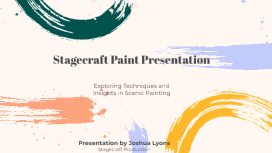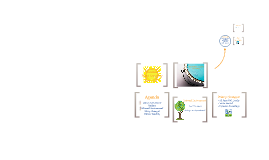Stagecraft Paint Presentation
Transcript: Preparation for Brick Painting Begin by cleaning the brick surface thoroughly to remove dirt and debris. Use a wire brush or pressure washer, and allow it to dry fully before painting to ensure proper adhesion of the paint. Brick Painting: Techniques and Tips Lessons Learned Challenges Faced Color Selection Effective Planning Stagecraft painting presents several challenges that can significantly impact the outcome and efficiency of a project. Brick painting enhances the visual impact of stage productions while offering challenges in preparation and execution. Effective planning and adaptation are crucial for successful scenic painting, ensuring quality results and efficient use of time and resources. Choose colors that align with the scene’s mood and the overall production design. Consider using sample swatches on a small area of the brick to visualize the final effect before committing to the entire surface. Thorough planning is essential in stagecraft painting. It involves understanding project requirements, estimating resources, and scheduling tasks to avoid last-minute challenges that can compromise quality. Surface Preparation Issues Weather Considerations Inadequate surface preparation can lead to poor paint adhesion and finish. Factors include moisture, dirt, or grease, which require thorough cleaning and priming before painting begins. Outdoor stage productions face variability in weather, affecting paint drying times and durability. Wind, humidity, and temperature all influence the final appearance and longevity of painted surfaces. Finishing Touches Application Techniques Time Management Adapting Techniques to Surfaces Color Matching Difficulties Once the paint has dried, inspect the surface for any uneven areas and touch up as needed. Applying a clear sealant can help protect the paint from wear during performances, ensuring longevity and vibrancy. Different surfaces require tailored painting techniques. Understanding the characteristics of each surface, whether wood, plaster, or fabric, influences the choice of paints and application methods for optimal results. Utilize a roller or brush for even paint distribution, ensuring coverage of all surface textures. Thin layers promote a better finish and allow natural brick texture to show through, enhancing the scenic effect. Efficient time management is vital in scenic painting projects. Allocating sufficient time for preparation, execution, and drying processes helps prevent rushed jobs and ensures the best outcomes for the painted surfaces. Achieving the desired color for stagecraft can be complex due to lighting variations and paint brands. It requires careful testing and documentation of paint formulas to ensure consistency across different setups. Spray Techniques Tool Maintenance Environmental Considerations Stencil Techniques Choosing eco-friendly paints and materials minimizes harmful emissions and waste. Proper disposal of paint and containers adheres to environmental regulations and promotes sustainability in the industry. Spray techniques are widely employed for their ability to cover large areas evenly and efficiently. Utilizing spray paint can achieve gradients, soft edges, and complex effects that are difficult to replicate by brush alone. Regular maintenance of brushes, rollers, and sprayers prolongs their lifespan and ensures consistent quality in painting. Cleaning tools immediately after use prevents material buildup and damage. Stencil techniques involve creating patterns and designs through cut-out shapes, offering precision in painting. This method is particularly effective for repeating designs and can add intricate details to larger set pieces. Half a Brick, Quarter Brick, Whole Brick Aye! Sponge Techniques Safety First Sponge techniques involve using sponges to create unique textures and patterns on surfaces. This method is ideal for simulating organic effects, such as clouds, foliage, or weathered materials, adding realism to stage designs. Implementing safety measures such as proper ventilation, using PPE like masks and gloves, and ensuring that materials are stored correctly can significantly reduce health risks during painting. Techniques in Scenic Painting Exploring Techniques and Insights in Scenic Painting Brush Techniques Best Practices in Stagecraft Painting Understanding various techniques enhances the effectiveness of scenic painting, key for creating immersive theatrical environments. Brush techniques are fundamental in scenic painting, allowing artists to create textures and layers. Techniques like dry brushing add depth while washes can create ambiance, enhancing the overall visual effect of the set. Prioritizing safety, equipment maintenance, and environmental responsibility enhances the effectiveness and efficiency of stagecraft painting. Presentation by Joshua Lyons Stagecraft Production "Experience is the best teacher" Latex Paint Goals of the Presentation Latex paint, also water-based, is known for its easy

















